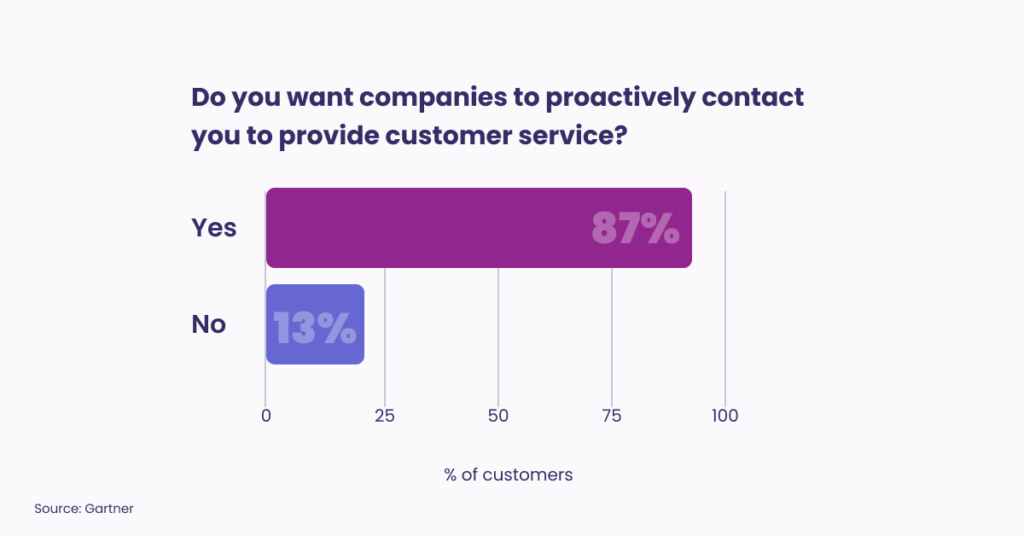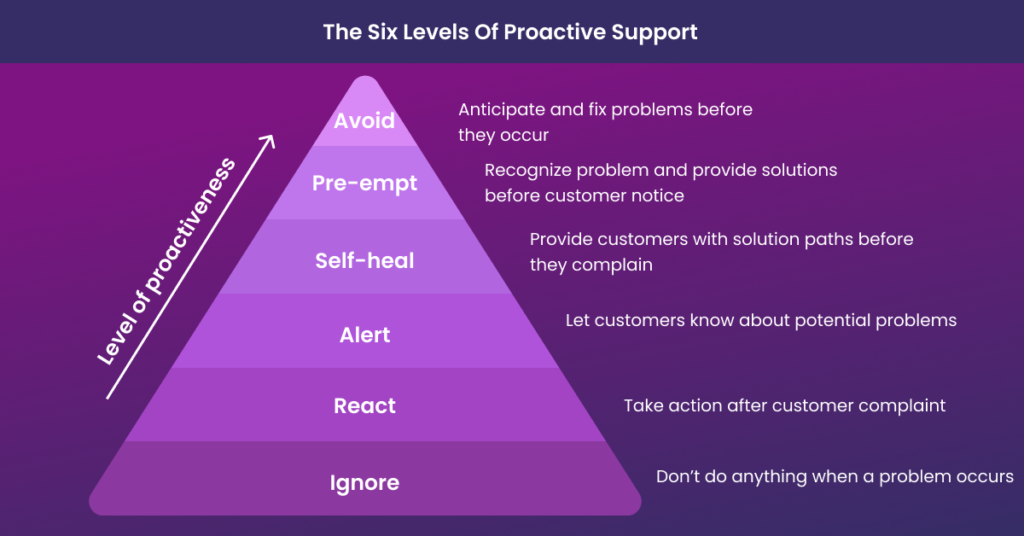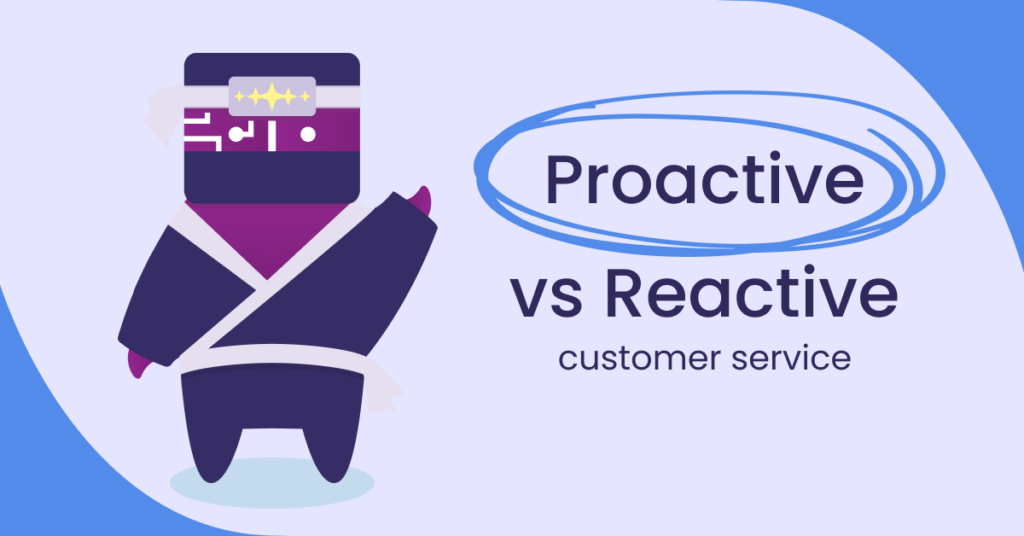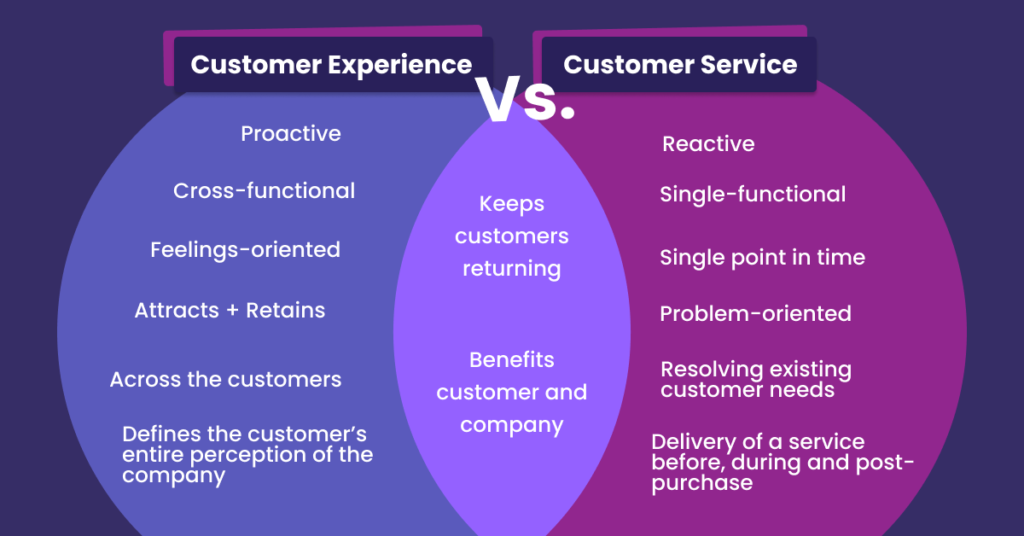The world has become a place of one-click ordering and instant delivery with proactive customer service still being a distinguishing feature on every front.
But for all its conveniences, it’s also a place where customers have zero tolerance for customer support that falls short of the best practices we’ve come to expect from support giants like, say, Amazon.
But why should customer service be proactive? We are already trying to improve customer experience with every interaction — isn’t that enough to stand out?
Turns out it’s not — Gartner found that 87% of customers would prefer companies to proactively reach out to them regarding issues related to customer service.

In this blog post, we’re going to analyze the value of proactive customer support and look at ways you can get your agents to be proactive at work.
What is proactive customer service?
The definition of proactive customer service is simple. It is all about taking proactive steps to prevent customer problems before they happen.
In other words, it is when you do proactive contact support to provide customers with comprehensive and anticipatory actions, without them having to reach out first.
This means proactive customer support going above and beyond for your customers, and making sure they have everything needed before they even know they need it.
In fact, there are six levels of proactive service, where you can go from ignoring customer problems when they come in to taking all the steps for those problems to never appear in the first place.

By taking proactive steps to prevent customer problems, you can reduce churn, increase customer satisfaction, and build long-term loyalty. So if you’re not already providing proactive customer service, now is the time to start!
Proactive vs reactive customer service

In essence, there are two types of customer service: proactive and reactive.
Reactive customer service is when you wait for the customer to come to you with a problem. Proactive customer service is when you try to solve the customer’s problem before they even have a chance to ask.
Gartner surveyed 6,000 customers and found that only 13% of them report any type of proactive customer service. However, that same research shows that proactive customer service results in a full percentage point increase in NPS, customer satisfaction score, and customer effort score.
Which one is better then? That depends on the situation.
If you have a proactive solution to a problem that the customer doesn’t even know they have yet — that’s amazing proactive customer service. On the other hand, if you’re just trying to upsell the customer on something they don’t need — that’s just bad business.
The key difference between proactive and reactive customer service is proactive solutions. If you can solve the customer’s problem before they even know they have it, then you’re providing proactive solutions and giving them an amazing customer service experience.
Additionally, proactive customer service can help improve your Net Promoter Score (NPS) and bring more business while simply focusing on your customers.
So next time you’re thinking about how to provide better customer service, ask yourself: am I being proactive or reactive? And remember, reactive customer service is preferred to a proactive system.
But, what are proactive customer service examples? Here are some of them:
- proactively checking in with customers after they make a purchase
- sending customized follow-up emails after important events
- offering live chat support on your website asking the customer if they need any help
On the other hand, examples of reactive customer service are:
- Attending a complaint ticket on chat, trying to solve the situation
- Customer calls to cancel a service — you offer them a retention package

Why build a proactive customer service team culture?
We don’t have to tell you how important it is to have an engaged team of support representatives. Well, have you ever considered whether your proactive customer service strategies could lay the foundation for employee engagement?
The Journal of Management describes proactivity like this:
| ” proactivity is a goal-driven process involving both the setting of a proactive goal (proactive goal generation) and striving to achieve that proactive goal” |
In other words, having a proactive mindset is focused on making things happen, anticipating and preventing problems, and seizing opportunities. Apply this to your service teams and you’ve got a group of agents who are motivated to do what it takes to reach their goal – deliver a seamless customer experience and ensure customer success.
At Kaizo, we’re interested in agent motivation and how properly engaging your agents can lead to stronger teams and happier customers. In a recent article titled The science behind customer service motivation, we explored what factors can influence behavior. When we want to help agents become intrinsically motivated. The idea is to create an environment that encourages them to achieve a goal in exchange for personal satisfaction.
Management research explains how engagement strategies can be built to support proactive motivation strategies and in return fuel an employee’s fire to continue to achieve goals by providing proactive contact support.
Proactive customer service is, at the end of the day, a strategy that delights both agents and customers. Agents can minimize their workload, challenge themselves to spot potential risks to customer experience, and activate their sense of control over service delivery.
Every day agents react to confused customers, helping them identify issues that could have easily been blocked with smart tech and a proactive care team. Customer service representatives are problem-solvers at heart. So you can imagine how answering the same inquiries time after time would have agents thinking up a few ways to optimize operations and consider the benefit of proactive service.
Long story short, a proactive customer service team culture is the way to go. Rid of distracting frustrations, agents are able to be more patient, empathetic, and clear-minded when handling difficult tickets.
Now we’ve answered the “Whats” and “Whys” of proactive customer support. Let’s explain how to deliver it.
How can AI help with proactive service?
AI has proven to be key not only for reactive customer service but for proactive customer support, too. A well-curated AI can evaluate data to provide the best next action in any scenario making your customer service operations more efficient.
In other words, with AI you can take proactive measures to avoid a potential service failure or give the best solution to a current situation.
According to Salesforce and HelpLama, here are some of the reasons why you should incorporate a proactive customer support strategy.
- 89% of consumers found proactive customer service to be a positive experience or a pleasant surprise
- 92% of consumers reported that the experience of being contacted proactively by the company changed their perception of the company in a positive way
- 87% of consumers said that a positive experience of proactive service propelled them to take positive action
- More than 50% of people across generations expect companies to engage them proactively
How to build a proactive customer service team
A lack of proactive support is a common problem that plagues many businesses. Customers are often quick to complain, whether it be on social media or through other channels, but rarely do they provide feedback or report issues when things go well. Zippia reports that more than half of customers surveyed – 53% – don’t believe companies take any action based on the feedback they provide.
Yes, customer service will always be a reactive business practice. However, we need to show our customers that we not only listen to what they need, but we learn from it as well.
Every company can implement proactive customer service processes that make the whole experience more pleasant and reduce customer churn over time.
In fact, building a proactive customer service team is easier than it seems. You need to make a plan, hire the right people, adopt the right technology, train agents to deliver proactive support, and create an environment of trust.
Here’s where you start.
Gather customer feedback to later integrate it in your strategy
To implement proactive customer service, businesses should first gather customer feedback to identify areas where improvements can be made.
Once potential problems have been identified, you can then develop proactive strategies to address them. This may involve anything from improving communication with customers to streamlining processes to better meet their needs.
By taking a proactive approach to customer service, businesses can improve the overall experience for their customers and build loyalty and goodwill in the process.

Develop a proactive customer support strategy
As with any strategy, you need to plan to be successful. When developing your proactive customer service team, remember to:
- Set clear goals and KPIs to drive agents’ performance
- Identify all the touchpoints that can have proactive service
- Empower your agents to make decisions and improvements
But before everything else, consider this: what can make customer service proactive in your specific case?
Think about what you can do to reduce friction for your customers.
For example, if you have an e-commerce store, consider adding automated enrollment in your rewards program based on positive shopping behavior.
If you’re an online marketplace, try implementing a tool that allows sellers to “claim” inventory they want to sell and update their item descriptions in your system — you can then automatically approve these listings and help them get off the ground more quickly by streamlining this process.
Enable your agents to do their best
It does not matter how determined your representatives are to do their best. Just as a car will have problems starting without gasoline, agents can’t succeed without the right software. You need to enable them in order to make the strategy work.
Your customer service agents are the frontline of your business and the catalysts of your proactive customer service strategies. So, they need to be equipped with the right tools to provide an outstanding customer experience. Practically speaking, agents need access to customer data, be able to quickly resolve issues, and do proactive calling. By giving your agents the tools they need to be successful, you can ensure that your customers will always receive the best possible service.
Some of the tools you can give your agents to be more proactive are:
- Live chat with skill-based routing: Having a smart Interactive Voice Response (IVR) would help you route the calls towards the most knowledgeable agents based on statistics from your business intelligence department.
- AI Chatbots: AI can help you be more proactive by monitoring your customer’s interactions on your web page, a well-configured chatbot can detect when a customer is taking too long to do a transaction and can offer help, opening an opportunity for an agent to take over if necessary
- CRM: A good CRM can make your callers reach proactive solutions for customer service a lot faster. Not having enough transparent information about your customers and their previous interactions can be detrimental to customer experience.
More than 75% of consumers expect customer service representatives to have visibility into previous interactions and purchases, according to Microsoft. Yet nearly half say agents almost never or only occasionally have the context they need to most effectively and efficiently solve their issue.
Mitigate unexpected issues
Providing live service disruption updates is one of the best proactive customer service examples.
Communicating openly with customers about service issues is a fantastic way to build trust, reassure customers with information that they cannot access themselves. Proactive calling and messaging solutions can also alleviate pressure on agents to provide answers to issues that are out of their control. And this proactive strategy can be useful for companies across all sectors.
We’ve seen our long-time user, Marley Spoon, use social media, messaging and chatbots to address food delivery delays. Zendesk utilized a service page to communicate tech disruptions, even going so far as to note when there are no system wide issues.
This year PWC identified that the luxury retail industry, businesses that typically value tradition, are leaning into the internationally recognized messaging and community app – Whatsapp.
Whatsapp comes in 3rd place for most-used social platform globally. When customers need to be notified about an urgent disruption, Whatsapp is your perfect solution. Customers will get updates and can engage in conversation with agents right there and then.
Get up-close and personal
Proactive customer service is about meeting the customer where they are. What better place to do that than social media channels?
In the past several years, Twitter has made a name for itself as the go-to platform for reactive service. However, we argue that Instagram is where customers are getting the personalized attention they crave.
90% of people currently follow a business on Instagram. Better yet, 2 out of 3 people report that Instagram allows them to interact with brands and build community. Contacting customers with resources, product guidance, and e-commerce for Instagram how-tos is just the tip of the iceberg. Social media is a rich channel full of possibilities to proactively engage your customers.
Unify all customer support operations within one platform
If you’re going to go ahead with the suggestions above, you’ll need customer support software that can handle omnichannel support, provide data-driven training activities, and support AI and time-saving automation. Oh, and of course, this system should provide all these solutions in one centralized location.
By creating a centralized hub for all of your support needs, team leads can monitor activity across different channels in one place. This way you can see what’s being said about your organization and respond accordingly without ever having to hunt for information or lose track of conversations as they move.
Having a unified system across all departments is important for streamlining the way support issues move through your organization. This way, everyone is on the same page in terms of how they communicate with customers, which helps keep things consistent.
Plus, getting serious about proactive contact support requires time and investment. Unifying your support management system will save you valuable time.
Learn more: Customer operations: support your support for happy customers
With Kaizo, you can have all the data at your fingertips. From quality assurance and performance management to agent motivation and performance coaching — you can make data-driven decisions and build plans that will always work.

Make a reliable knowledge base
A good knowledge base should contain all your customers’ most frequently asked questions.
This will save your customer service agents valuable time. Plus, your agents can contribute to your knowledge base and provide proactive customer service ideas. This type of involvement further empowers agents as experts on your product or service and how it’s used.
A good knowledge base should have these three elements. It needs to be accessible, answer the most frequently asked questions (FAQs), and also address the questions that you anticipate your customers might have.
FAQs can come in many forms. Some companies utilize AI Chat boxes to display FAQs specific to the webpage the customer is reviewing. For example, an FAQ Chat Box pops up during check-out to explain the available payment methods and shipping costs.
Ask yourself — what are the questions behind the question? What should your customer really be asked to solve their problems?
Anticipate what question they will have next. You should be addressing these as well! And since your customers don’t know they should be asking these questions, be sure to promote them in related knowledge base articles.
Learn more: VIDEO: Building a strong product feedback loop with Revolut & Swapfiets
Continuously coach your agents
Constant feedback and coaching is key when implementing customer service strategies. Be sure to keep your eyes open for learning opportunities and help agents get better using their own performance data when giving actionable advice.
As a manager or supervisor, it is your responsibility to consistently communicate with your team. After all, the only way your agents can identify if they are doing a great job or not is through constant feedback that you get in a company with a strong coaching culture.
Moreover, identifying strengths and weaknesses is key to developing your team and proactive customer service strategies. Unlike their experiences with other platforms, our users have found Kaizo to be an amazing resource for coaching their agents. Capital shared that Kaizo’s data visibility and user-friendly interface helped their agents feel less ashamed about their need for more training.
Proactive customer support can feel unintuitive to agents, especially those new to the game or locked into outdated strategies. But with support from platforms like Kaizo, which help teams support each other and learn from their own performance data, adopting new strategies will be much easier.
Reward your team for proactiveness
Outstanding customer service does not happen by accident. It requires proactive employees who are always looking for ways to improve the customer experience. When these agents go above and beyond, they should be recognized and rewarded for their efforts.
There are many ways to reward proactive customer service representatives. One way is to give them a bonus or commission for each interaction with NPS 9 or 10. Another option is to provide them with vouchers for free dinner or a day at a spa.
Of course, cash is always welcome. However, whatever you do, make sure the reward is meaningful and motivates the proactive customer service representative to continue providing outstanding service. When you invest in your team, you invest in your company’s future.
Read more: 14+ tips for rewarding employees for great customer service
Even when resources are low, there are ways to weave rewards and congratulatory engagement into your workflow. Kaizo is designed with gamification elements in mind. When agents hit their personal goals via the Kaizo Missions, their avatar — a personally customized Kaizo Ninja — unlocks new digital items to display with pride.
Making work rewarding has more impact on productivity than you would think. This is the very reason why Kaizo leverages gamification — it is a great way to keep people engaged and interested in building skills, like proactive service. In fact, Zippia statistics show that 72% of people say that introducing gamification into the workplace motivated them to do tasks and work harder. By adding a level of challenge and competition to implement your new service strategy, Kaizo’s gamification can help employees stay focused and motivated.
Wrapping up
Proactive customer support is a hallmark of a standout brand. It stands out in the age of social media and online reviews, where the most talked-about brands are those that make it their mission to respond to customers’ needs.
Customer service is no longer just answering customers’ questions as they come in — the most successful companies are using proactive support strategies to anticipate customers’ needs, solve problems before they occur, and build loyalty with customers.
Are you ready to be one of them?


